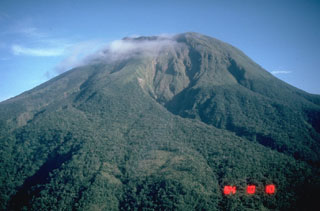Report on Bulusan (Philippines) — 14 June-20 June 2006
Smithsonian Institution / US Geological Survey
Weekly Volcanic Activity Report, 14 June-20 June 2006
Managing Editor: Sally Sennert.
Please cite this report as:
Global Volcanism Program, 2006. Report on Bulusan (Philippines) (Sennert, S, ed.). Weekly Volcanic Activity Report, 14 June-20 June 2006. Smithsonian Institution and US Geological Survey.
Bulusan
Philippines
12.769°N, 124.056°E; summit elev. 1535 m
All times are local (unless otherwise noted)
An explosion from a fissure W of the summit vent of Bulusan lasting approximately 13 minutes on 13 June produced an ash-and-steam cloud that reached a height of 1.5 km above the summit (10,100 ft a.s.l.) and drifted NW. Ashfall up to 7 mm thick accumulated in neighborhoods in the municipality of Juban. On 18 June, an ash producing explosion that lasted approximately 11 minutes produced an ash-and-steam cloud that also reached a height of 1.5 km above the summit (10,100 ft a.s.l.) and drifted W. Ash up to 5 mm thick fell on a W flank village. On 20 June, a mild ash-and-steam explosion lasted approximately 17 minutes. Close to 900 people were evacuated due to the 18 June activity. On 20 June, officials declared a state of disaster for Irosin, Casiguran, and Juban towns in Sorsogon province. Bulusan remained at Alert Level 2 (out of 5 levels) during 14-20 June.
Geological Summary. Luzon's southernmost volcano, Bulusan, was constructed along the rim of the 11-km-diameter dacitic-to-rhyolitic Irosin caldera, which was formed about 36,000 years ago. It lies at the SE end of the Bicol volcanic arc occupying the peninsula of the same name that forms the elongated SE tip of Luzon. A broad, flat moat is located below the topographically prominent SW rim of Irosin caldera; the NE rim is buried by the andesitic complex. Bulusan is flanked by several other large intracaldera lava domes and cones, including the prominent Mount Jormajan lava dome on the SW flank and Sharp Peak to the NE. The summit is unvegetated and contains a 300-m-wide, 50-m-deep crater. Three small craters are located on the SE flank. Many moderate explosive eruptions have been recorded since the mid-19th century.
Sources: Philippine Institute of Volcanology and Seismology (PHIVOLCS), Canada.com (Postmedia Network), Philippine Information Agency, Reuters

